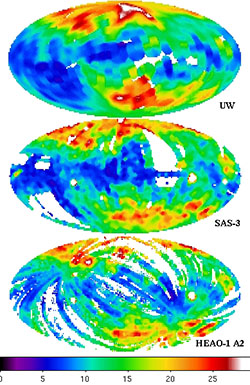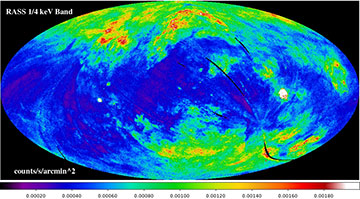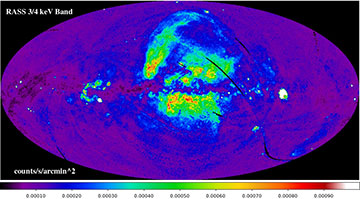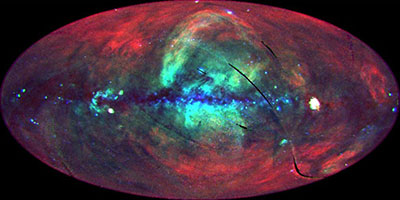Soft X-ray Diffuse Background
The diffuse soft X-ray background (SXRB) is a combination of more than five different X-ray emitting components that emit in the lower-energy end of the X-ray spectrum, which are spread over an extremely wide volume of space. Its structure, thinking three-dimensionally, includes bubbles like the empty holes in a sponge, or Swiss cheese, which occasionally inter-connect. These bubbles are contained in the disk of the galaxy, and can range in size from less than 50 to greter than 200 parsecs in diameter. The nature of the SXRB varies over its energy range. At its lowest energies, almost all the SXRB begins as thermal emission from hot matter (for example, carbon, nitrogen, oxygen, neon, magnesium, silicon, and iron). Any part of the interstellar medium (ISM) that is hotter than 106 degrees K must have been made by some extreme methods such as supernovae and the stellar winds of early-type stars.
Early X-ray Observations
The study of the 1/4 keV band of the SXRB – which corresponds to the photon energy range of 0.1 to 0.3 keV – began in the late 1960s with sounding-rocket observations. The rocket studies were necessary because X-rays at these lower energies do not travel far in Earth's atmosphere (about a millimeter at sea level), so as with other X-ray astronomical studies, the observations had to be done at altitudes higher than 200 km, above Earth's atmosphere. From these first observations, the 1/4 keV background showed a surface brightness that was both intense and that varied with the direction in the sky from which the source was originating. With the somewhat poor angular resolution of these early experiments, the most obvious feature was a general trend of greater intensity at high galactic latitudes – that is, above and below the galaxy – than in the plane of the galaxy. In the "absorption model," it appeared that the SXRB originated outside the galaxy, and that the variation of intensity was due to absorption by the interstellar medium (ISM) in the galactic disk. The flux from the galactic plane was attributed to an additional non-cosmic-background component that could not be identified and removed.

However, with additional independent observations, the local interstellar medium became a candidate when it became apparent that the flux observed in the galactic plane was very likely to be cosmic (originating beyond the solar system) in origin. This and other inconsistencies of the absorption model were explained by having a local (nearest 100 pcs), unabsorbed component. From this point, discussions of the origin of the SXRB became tightly linked to models of the local ISM.
In the 1970s and 1980s, great strides were made in improving the quality of the data by increasing sky coverage as well as the angular and spectral resolution of the instruments doing the observations. During this time, different groups presented data collected using a variety of methods, all of which were consistent with each other. Figure 1 shows three early all-sky surveys conducted by the University of Wisconsin, Massachusetts Institute of Technology, and Pennsylvania State University.
By the mid-1990s, the ROSAT mission added a fourth independent all-sky survey in the 1/4 keV band (one from a campaign of sounding-rocket flights, and three from satellite experiments). Figure 2 shows the 1/4 keV band maps from the ROSAT survey. Compare this to Figure 3, which shows a map of galactic Hydrogen I emission.

Credit: The Max Planck Institute for Extraterrestrial Physics, Snowden et al.1995, ApJ, 454, 643

Credit: The Max Planck Institute for Extraterrestrial Physics, Snowden et al.1995, ApJ, 454, 643

Credit: The Max Planck Institute for Extraterrestrial Physics, Snowden et al.1995, ApJ, 454, 643
Comparing Figure 2 with Figure 3, one can see a negative correlation – that is, whereas there is a lot of "empty" space in the plane of the galaxy in Figure 2, there is a lot of hydrogen in the plane in Figure 3. Figure 4 shows the 3/4 keV band map from the ROSAT survey. Except for a few distinct galactic features, the structure in the 3/4 keV band is very different than the 1/4 keV band. The largest feature is Loop I, a ring of stronger energy emission at the center of the galaxy. This is thought to be a supernova remnant/stellar wind bubble at a distance of 150 parsecs and a radius of ~100 parsecs. Figure 5 shows a false-color image of the soft X-ray sky where red indicates the intensity in the 1/4 keV band, green the 3/4 keV band, and blue the 1.5 keV band.
Overall, in the 1960s through the 1990s, the angular resolution of the X-ray observatories wasn't sufficient to get a complete count of the sources in a given field of view. With the advent of Chandra and XMM, that ability was improved.

Structure and Importance
As mentioned before, the structure of the SXRB can be likened to a natural sponge, or Swiss cheese. The holes are rather big, because the ISM is very dynamic. There are supernovae going off, and when that occurs, a lot of energy is released, which sends material out that sweeps out cavities in the ISM, pushing it like a snow plow pushes snow around. Occasionally, the piles of matter will run into each other, and can sometimes get "frothy." It begins as a structure that is very thin and flat, and the neutral hydrogen that we see is in the arms and uniformly distributed. That uniformity is disrupted once supernovae begin pushing things around. Each of these bubbles contains hot matter, and as the bubble ages, it grows larger and cools.
Our Solar System lies within such a bubble, called the Local Hot Bubble. This structure is very old, but plasma at a million degrees doesn't cool quickly, so it can be around for several million years and remain relatively hot.
Structure can be determined by looking at the distribution, and content can be determined by looking at the SXRB at specific wavelengths. The late 1970s and 1980s saw lots of work in energy ranges other than in the X-ray portion of the spectrum that had an impact on our understanding of the local interstellar medium. Locally, a lack of neutral material of the galactic disk was observed. ISM absorption line measurements of the spectra of relatively nearby stars were used to show conclusively that there is a local cavity in the neutral hydrogen (HI) of the galactic disk which surrounds the Sun (but is unrelated to the Sun). The path lengths of low HI space density vary considerably even in the galactic plane with values ranging from tens to hundreds of parsecs. Even the "cavity" was shown to be a complicated region with a partially ionized component of limited extent surrounding the Sun and significant path lengths of ionized hydrogen (HII) gas in at least one direction. Besides having regions of HII gas, the local cavity in the HI was a logical place to put the hot matter responsible for the local component of the SXRB (that which is observed in the galactic plane).
Another way of determining the location of the X-ray emitting gas is to look for "shadowing" caused by foreground clouds in the interstellar medium. This is clearly demonstrated by the X-ray intensity variation in the direction of the Draco Nebula (Figure 6). The left-hand image shows the 1/4 keV band X-ray intensity (purple is low, red/white is high) and the right hand image shows the IRAS 100 micron intensity (a measure of the material in the ISM similar to HI). The 1/4 keV band is clearly shadowed by the Draco Nebula indicating that in this direction there is extensive emission originating beyond the Nebula.

Observations of the HI line of the spectrum is fundamental to understanding the structure of the universe, because it is where neutral hydrogen resonates. For neutral material, the stronger the signal at the wavelength where the neutral hydrogen signature line can be found, the more material there is along the line of sight. That's a way of measuring how much mass there is between us and whatever we think we're looking at. That is critical, because HI – and more practically, the metals that are with the neutral hydrogen – absorb X-rays, and they are good at absorbing X-rays at 1/4 keV. The variation that we see is not necessarily the variation of how much stuff is out there emitting it, but is more a combination of variations in the source, and how much of the source emission is being absorbed as it travels along the line of sight to us. HI is important in understanding the 1/4 keV background, because it helps us understand the 3D distribution of the plasma, gas, or whatever is producing the X-rays.
Thanks to Steve Snowden
Last Modified: October 2012


